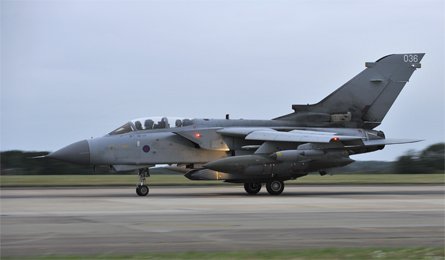The UK is to scale back its equipment contribution to NATO's Operation Unified Protector campaign, but has said its decision will not reduce its current fast jet sortie rate over Libya.
Announced on 21 September, as the North Atlantic Council agreed to extend the campaign's mandate by a further 90 days until late December, the UK's decision will lead to the withdrawal of four Eurofighter Typhoons (one pictured below) and three Westland/Boeing Apache AH1 attack helicopters from the Mediterranean region.
"The good progress made to date will allow us to bring home four Typhoon fast jets and three attack helicopters in the near future, without affecting our ability to continue enforcing UN Security Council Resolution 1973," said Defence Secretary Dr Liam Fox.
 |
|---|
© Sgt Pete Mobbs/Crown Copyright |
Describing the UK's support for the NATO mission as "unwavering", Fox said its operation "Ellamy" contribution will retain 16 Royal Air Force Panavia Tornado GR4 strike aircraft, forward-based at Gioia del Colle, Italy, and two Army Air Corps Apaches. These will remain in-theatre "for as long as required".
UK military aircraft and naval vessels have now struck almost 1,000 targets since the start of international action against the regime of Col Muammar Gaddafi.
In its most recent operational update, the UK Ministry of Defence said a package of Tornados and Typhoons struck two command and control facilities in Sirte early on 21 September.
The Tornado force also continues to conduct long-range strike missions, launched from RAF Marham in the UK and using MBDA Storm Shadow cruise missiles (below).
The most recent of these, performed on 14 September, saw a number of the weapons employed against a military vehicle depot and a pro-Gaddafi base near Sebha.
 |
|---|
© SAC Simon Armstrong/Crown Copyright |
In an operational first, the following day a formation of Gioia del Colle-based GR4s struck what the MoD described "a large concentration of former regime armoured vehicles", during a salvo firing of 24 millimetre-wave radar seeker-equipped MBDA Brimstone air-to-surface missiles.
Previous combat use of the Brimstone had been restricted to using weapons modified with a replacement dual-mode seeker."Seven or eight target vehicles were observed on fire, and the precision nature of the Brimstone's warhead means that additional targets were most likely destroyed or severely damaged," the MoD said.
Source: Flight International



















